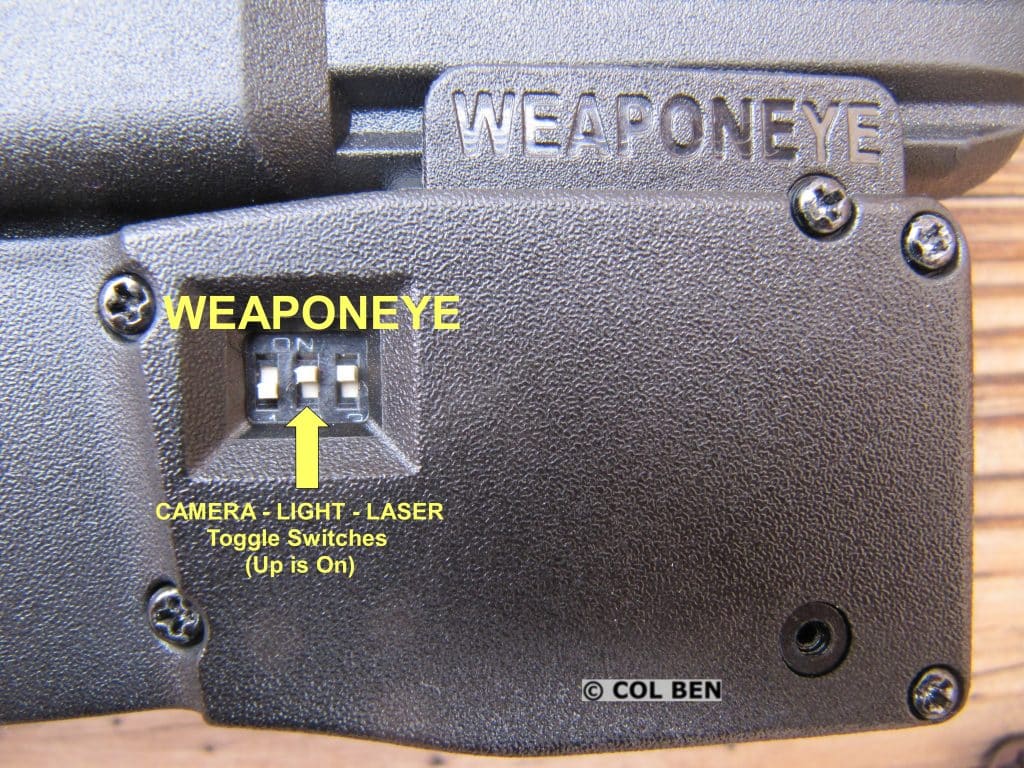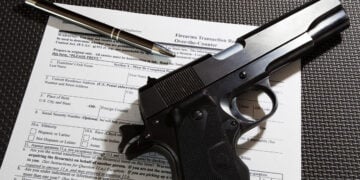Whenever you as a law-abiding Concealed Carry citizen are involved in a deadly-force shooting, much is at stake, even when you acted according to the law. More than not, you the innocent defender will be arrested and charged with the felonious use of your gun until the facts of the situation are determined. Then there is the high-cost necessity of hiring a criminal defense attorney for yourself. Estimates for this for a typical felony case are from at least $10,000 to well over $100,000, depending on case complexity and the jurisdiction. And the burden of proof is generally on you the righteous self-defense shooter, to show that you used your handgun legally in self-defense, depending on your state laws. To give yourself an edge, you need to prepare in advance with the best equipment and accessories before using your weapon in any deadly-force encounter. Technology can be your friend.
For the past few years, police have used body cameras for many reasons, including gathering evidence in deadly-force encounters. Between 2015 and 2017, law enforcement agencies in 45 states and the District of Columbia have received about $58 million in funding from the Department of Justice’s Body-Worn Camera program. But there have been mixed reviews and results from their use. Some say they do not provide definitive footage to adequately determine and provide a proper view of why and exactly when the gun was fired, among other criticisms.
New Supplemental Self-Defense Tool
To help determine and easily and automatically record exact self-defense facts, evidence, and support your legal actions and decisions, there is now a supplement tool in addition to the use of body cameras, for example, as used by the police. Body cameras and even cell phone cameras can be cumbersome, not instantly available, show lesser-quality images, and not sufficiently record exact footage in stressful civilian situations that require unblocked, precision footage.
That new tool to help civilian Concealed Carriers in their self-defense, as well as for training, is a Weapon-Mounted Camera with video and audio capabilities. A laser sight and a tactical LED light can also be mounted with the high definition camera. This new tool just may help you show that your deadly-force actions in self-defense were justified. And it may save you a bunch of money, time, and headaches in court. Typical Weapon-Mounted systems range in price from about $150 to $599. The price depends on the desired features, and if a light and/or laser is also included.
There are two often-used Weapon-Mounted Camera systems: Weaponeye from Atlas Pilot-Tactical and Beyond and XTL and X5L models from Viridian Weapon Technologies.
So why a Weapon-Mounted Camera and not a body camera for civilian Concealed Carry? Of course, there are pros and cons for both systems, and they both may be used simultaneously.
Studies Indicate that Body Cameras Are Not That Helpful
Some recent valid studies conclude that body cameras used by the police do not capture adequate data to evaluate the reason why individuals fired their weapon. These conclusions seem logical for any body camera user, including civilians as well. But, do these same conclusions also apply to Weapon-Mounted Cameras?
Viridian Weapon Technologies performed an in-depth study on body cameras. They found that only 37% of the time do body cameras adequately capture the view necessary to evaluate the reason officers fired their weapons. So, is there current technology that will allow improved capture of the required data?
Body cameras can capture evidence prior to the officer drawing their gun. But in more than two-thirds of the cases studied the events leading to the officer drawing the gun were not in question. Rather the reason the officer actually fired the gun was the critical evidence to be determined in 93% of all reviewed incidents, according to the Viridian study. This would also seem to be true for civilians.
The Williams, Arizona Police Department was one of the first police departments in the U.S. to adopt the Weapon-Mounted Camera technology. Lieutenant Darrell Hixson explained that the department already has body cameras. But they didn’t feel the body cameras were necessarily dependable to capture crucial information in the moment of the shooting. So the department turned to Weapon-Mounted Camera technology that attaches to a rail beneath the weapon’s muzzle.
CAUTION: Remember, when a well-intentioned individual in a self-defense situation draws and points a gun (with a camera, light, and/or laser attached) at someone, they are pointing a loaded gun. This may lead to a complicated legal situation.
Determining what the shooter saw when pressing the trigger is what is really important, as indicated by the many controversies of past incidents and trials. Chief Herman Nixon of the Williams, Arizona Police Department echoes the primary focus and importance in determining what the person saw from an unobstructed view when pressing the trigger. What is important for legal evidence is providing an unblocked view from the muzzle end of a handgun’s barrel and automatically recording it, rather than an obstructed body-camera view.
POINT: A Weapon-Mounted Camera located near the gun barrel’s muzzle and steadied by two hands is not obstructed by the shooter’s hands immediately in front of or very near a body camera nor by frequent upper body movement, as with a chest-mounted body camera.
Force Science Institute Studies
Research by the Force Science Institute indicates that body cameras have benefits and can be helpful to investigators. But there also seems to be evidence that they are not as helpful as first thought. Body cameras “can be fraught with limitations that must be understood in order to ensure fair, accurate and thorough investigations.” But what about the benefits and limitations of Weapon-Mounted Cameras? To this author, it seems that some of the same limitations apply, along with their many advantages.
“Rushing to condemn an officer for inappropriate behavior based solely on body-camera evidence can be a dicey proposition,” cautions Dr. Bill Lewinski, executive director of the Force Science Institute.
I believe that this same caution applies to Weapon-Mounted Cameras and civilian use. They are but one tool to use and to use properly. Any camera can provide more information about what happened during the deadly-force encounter. But it cannot necessarily provide ALL the information needed to make a fair and impartial final judgment. There are just too many variables, complexities, and partial and unclear video images that might be misleading, both in the encounter and in any camera itself. Maybe you need an ultra-wide Fisheye type of camera lens to see a fuller view, rather than a zoom? Maybe the aperture range setting to let in more or less light needs to be changed? Perhaps you need the finer quality definition of an optical zoom, versus a digital zoom to enlarge the zoomed area although with less resolution quality?
POINT: There are many detailed and subjective factors in the camera settings and in the deadly-force encounter that may significantly influence judgments and outcomes. Human factors, for example, significantly influence behaviors and events, apart from what the camera focuses on and sees. So partial information from any camera alone is not sufficient and may at times actually be deficient and misleading. However, Weapon-Mounted Cameras do provide useful information.

Camera Considerations and Impediments for Your Planning
Some studies indicate certain considerations and possible impediments for cameras on the body and/or on the handgun. Here are some things for you to consider and plan for in advance.
1. Important encounter details can be lost due to camera speed and time gaps.
Body and weapon-mounted cameras usually record at higher speeds than typical home and business security cameras and cell phones. So, key details can be lost in the millisecond gaps between frames. Also, reactionary times can be misleading but beneficial in context.
“Because of the reactionary curve, an officer can be half a second or more behind the action as it unfolds on the screen,” cautions Lewinski in his studies. Whether someone is shooting or stopping shooting, his recognition, decision-making, and physical activation all take time but may be misrepresented and not shown on camera.
2. Cameras do not record Depth of Field, the third dimension.
Cameras only record in 2-Dimension, not in 3-D. The human eye sees in the third dimension, so accurately judging footage distances can be difficult and incorrect. Distance distortion is common.
A Concealed Carrier’s use of force may seem inappropriate because the attacker appears to be too far away to pose an immediate threat. But, it is not technically true, and there is distortion.
3. A camera views a broad scene and may not represent your actual field of view and visual perception during the attack.
If an individual glances away from where the camera is aimed and concentrated, the camera may not see the action or movement within the camera frame that actually occurred. Also, a camera cannot view or represent psychological and physiological behaviors or events that you experience under high stress. The brain may suppress certain incoming visual images as not important in a life-threatening situation. You may very narrowly focus only on certain aspects of the threat and the camera may not show this. There can be significant difference between your sense of what happened at the time it was occurring and what the camera recorded. This can result in major misinterpretations, erroneous conclusions, and maybe jail time for you.
4. Tactile cues and certain important perceptive dangers that you felt cannot be recorded.
It may appear from a video image that you initiated an unprovoked attack because the sensory cue you felt does not record visually. Perceptions by touch and feel cannot be adequately shown by cameras. Concealed Carriers and officers sometimes rely partially on perceptions to decide to use or not use force. You can usually tell when you touch an attacker whether or not he is going to attack or resist. So you may quickly apply force, as Lewinski’s studies suggest.
5. Privacy concerns, access to camera footage, misuse of footage, and legal concerns exist.
In 2016, the Leadership Conference on Civil and Human Rights issued guidelines for comparing the wide variations in body-worn camera practices. The guidelines were primarily for law enforcement, but they are also germane to civilian use. These may apply to civilian Weapon-Mounted Cameras as well, but research this for your state and jurisdiction. Some states limit officer discretion on when they should and should not record, while others do not. Some specify who can view or access the footage, limit retention of footage and any alterations, and limit the use of biometric technologies such as facial recognition, etc. These same guidelines could also apply to civilian use of Weapon-Mounted Cameras, but there are other different considerations for civilians. Some states specify much of the above while other states do not.
POINT: There are concerns for civilian use of Weapon-Mounted Cameras when recording video footage and when recording audio/sounds, which vary by state and jurisdiction. These are especially concerns for those Concealed Carriers who must spontaneously deal with deadly-force encounters or any Concealed Carry event. It is very difficult, if not impossible, to anticipate dangerous and quickly-occurring lethal encounters and to secure necessary advanced permission from an individual(s) about to be recorded, or after recording video and audio? Are there legal limitations, applicable privacy laws, and required procedures for the use of the footage in your jurisdiction? Who can view and access the footage? There is a difference between legal regulations for audio and video recordings, as this non-legal layman understands.
Video and audio recordings may incidentally and unintentionally pick up video and audio footage of victims of violence or sexual assault, in various states of undress. Individuals and vulnerable people need to be protected from privacy violations, especially children.
CAUTION: State laws vary considerably about use of Weapon-Mounted Cameras with regard to video and/or audio recordings. Check your state and jurisdictional laws and consult with your attorney BEFORE you record anything, with this technology.
Florida’s Two-Party Consent Law
In my state of Florida, there is a wiretapping law, referred to as the “Two-Party Consent” law. In Florida, it is a crime to record or intercept a “wire, oral, or electronic communication,” unless ALL parties to the communication consent, per Florida Statute 934.03. While this non-legal person understands that it is generally legal to videotape someone in Florida, you are not permitted to record a conversation without the person’s consent. This non-attorney legal layman also understands that Florida law makes an exception for in-person communications when the parties do not have a “reasonable expectation of privacy,” such as when they are engaged in public place interactions that might reasonably be overheard.
So this non-attorney thinks this would apply to video recordings in Florida and you PROBABLY may record these kinds of communications without breaking the law. But, if your recording picks up a conversation or some audio, you might inadvertently violate your state’s wiretapping law, if it exists. So, verify for yourself in your location and be careful to not be a test court case.
Public Place Use of Cameras
It is my non-legal layman’s understanding that the United States Constitution does not protect citizens from unauthorized camera videotaping. However, this non-attorney understands that states are permitted to pass their own related laws, and many have done so. In my state of Florida, it is my understanding that anyone can use video surveillance equipment in public places to deter burglars and prevent crime. This is not a legal opinion. But, the law does not protect voyeurs who secretly film individuals where they have a “reasonable expectation of privacy,” such as bedrooms, bathrooms and other places they might engage in private acts.
CAUTION: Recognize that in addition to subjecting you to criminal prosecution, violating Florida or any state’s privacy and consent laws can also expose you to civil lawsuits for damages to an injured party.
So, investigate and know the law in your state and any state before recording others there by either audio or video recordings. It is always best to get the consent of all parties before recording any audio and video in-person communication or any telephone conversation or interaction. Of course, this may not be practical or possible during quickly escalating encounters.
NOTE: Some Concealed Carry civilians may not have the instant real-time capability to be able to engage, record, and to manually disengage their Weapon-Mounted Camera, since some are automatically turned on and off when drawn from the holster or replaced in it. A useful feature, but a personal preference and remember to be cautious. Some camera systems do not automatically engage upon draw from a holster and must be manually turned on and off.

Weapon-Mounted Camera: Example Specifications and Features for Weaponeye System:
The range of Weapon-Mounted-Camera systems includes a fine basic-features model with HD Camera, Red Laser, and Light at a moderate price, Atlas Pilot’s Weaponeye at $150 MSRP. A full-featured Viridian’s X5L Gen 3 with Green laser, a 500-Lumen LED Tactical Light, and HD Camera with Instant-On technology has an MSRP of $599. Here are some of the specifications and features of the Weaponeye Weapon-Mounted Camera system. In a few weeks, I shall review here the Viridian X5L camera system, so check back for its features and details.
| Feature | Data |
|---|---|
| Camera with Microphone for Sound | 720p High-Definition Camera |
| Battery Type | Rechargeable Lithium |
| Battery Life (constant) | About 40 minutes while Recording; Includes Mobile Battery Pack to Help Prevent Battery Drainage |
| Recording Time | About 4-5 hours at 720p on 8GB SD Card (also uses a 32 GB SD Card) |
| Mounting | Rail and Front of Trigger Guard (easy installation) Designed to fit All Glock Rails and most AR-15 rifles |
| File Footage Transfer | USB Port Cable Included for Uploading & Charging |
| Special Features | Engaged by Easy to Use Switch Below Trigger Guard |
| Holsters | Fits most holsters designed for lights (includes a holster) |
| Light Lumens | About 20 Lumens; LED |
| MSRP | $150 |
| Laser Type and Range | Class III Red Laser with About 100 yards Range; Wavelength is 5205 nm +/- |
CAUTION: Laser radiation is dangerous, so avoid eye and skin exposure to direct or scattered radiation. Do not stare into the laser beam.

Advantages of Weapon-Mounted Cameras
Well, all is not lost or negative when using Weapon-Mounted Cameras. Here are some benefits.
1. Increase the Safety of the Public and Concealed Carriers.
People act differently when they are being video and audio recorded. So this may incidentally encourage lawful and good behavior and lead to a decrease in violence and attacks. A study in Edmonton, Canada found that 35% of body camera users, for example, experienced a decrease in physical aggression by members of the public. Another study in Rialto, CA, found over a 50% reduction in use of force incidents when body cameras were worn. The same could be true for Weapon-Mounted Cameras.
2. Improve Justification for Deadly-Force Actions and Legally Protect Concealed Carriers.
Quality cameras provide distinct video and audio recording evidence that independently verify what happened in any deadly-force situation. No fake evidence or exaggerated subjective claims. But rather objective factual evidence of what happened from the time the gun was drawn to when it was fired.
3. Help Training, Learning, and Actual Practice.
Video and audio recordings can be used to train Concealed Carriers (and to record students) in very specific techniques and practices in realtime deadly-force scenarios and drills. I really like this benefit and it is a great training tool. An encounter situation and its several variables with actual responses can be recorded. Then they can be reviewed later to show the student what they did correctly and what needs to be improved. Insurance and reinforcement that the correct behaviors will be demonstrated in realtime and actual deadly-force situations and practice.
For range drills and actual practice, a Concealed Carrier can review how and what they did when practicing and see and hear any possible mistakes in shooting fundamentals and responses. The shooter can observe firsthand their limp wristing, improper grip, failure to safety check their gun, riding the slide, trigger control error, sight picture mistake, incorrect stance, flinching, milking error, etc. On a positive note, the laser helps accuracy and records it to show your skill to friends.
Conclusions
There are many approaches, devices, and technology to help Concealed Carriers and civilians recognize, understand and apply deliberate actions with a pistol to protect themselves during and after a deadly-force encounter. Each with its own advantages and disadvantages, as some studies indicate. Perhaps, there is not a single tool that provides all possible information and data to support and legally defend anyone’s actions in an encounter. A body camera has its pros and cons.
A new self-defense tool, the Weapon-Mounted Camera, offers a practical and very useful way to help civilians as Concealed Carriers. Understand the audio and video recording laws in your area since a few states and jurisdictions have limitations. The two popular systems are the moderately-priced and basic Atlas Pilot’s Weaponeye and the feature-rich and higher-priced Viridian X5L camera-laser-light systems. I like both of them, will probably use one very cautiously, and will get necessary permissions in various situations as appropriate, after much training and considerable practice. Decide on the features and what you want to pay for. Whatever tool you choose, ensure you understand its many variables, applications, pros and cons, legal parameters, and uses, such as for Concealed Carry, drills, and training. Would you use it for Concealed Carry in your state? Perhaps, the Weapon-Mounted Camera is for you?
Images by Author, Atlas Pilot Weaponeye, and Viridian Weapon Technologies.
Thanks to Atlas Pilot and Tactical and Beyond for sending me the Weaponeye to review and field test. They can be contacted in Miami, FL 33177 at 305-460-2228. Their website is www.Weaponeye.com.
* This personal opinion article is meant for general information & educational purposes only and the author strongly recommends that you seek counsel from an attorney for legal advice and your own personal certified weapons trainer for proper guidance about shooting & using YOUR firearms, self-defense and concealed carry. It should not be relied upon as accurate for all shooters & the author assumes no responsibility for anyone’s use of the information and shall not be liable for any improper or incorrect use of the information or any damages or injuries incurred whatsoever.
© 2019 Col Benjamin Findley. All Rights Reserved. This article may not be reprinted or reproduced in whole or in part by mechanical means, photocopying, electronic reproduction, scanning, or any other means without prior written permission. For copyright information, contact Col Ben Findley at [email protected].








